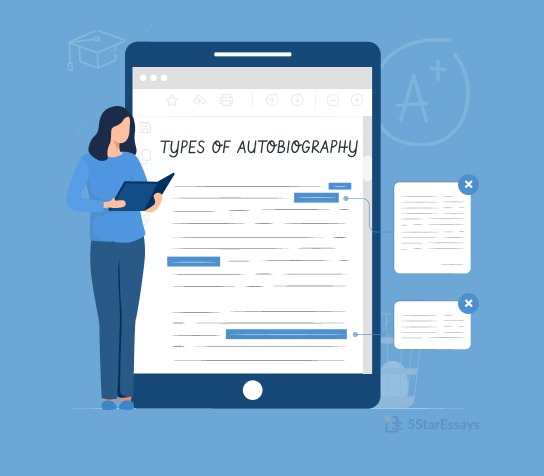What is an Autobiography?
An autobiography is a type of self-written story of your life. This type of narration has several purposes and goals depending upon the kind of writing you decide to go with.
Autobiographical writing has different types. You can choose from them based on what you want to include in your story.
Don’t confuse an autobiography with a biography – they’re completely different types of writing.
A biography is an account of someone’s life, the different events a person experiences throughout their life. However, the writer is someone else. The person who wants to share their life story gets someone else to work with them and write their story. You must have seen biographies of a famous person such as Abraham Lincoln.
Four Major Types of Autobiography
These are some of the structures that you must choose from before you decide to write.
Traditional Autobiography
This is a complete story about your life covering all events that shaped you starting from birth, childhood, adulthood to the present day. You can write it for your personal use to document important life events and preserve memories.
If you feel that your life is interesting, or it'll be motivational for others, then you can write it for the wider public. Give them a chance to learn more about the real you and learn from your accomplishments or failures.
Memoir
Writing a memoir is a good idea for someone who doesn't want to discuss their entire life journey. A memoir focuses on a particular event, relationship, time period, or place that had an effect on the person's personality and life.
For instance, a memoir about a place can talk about your hometown where you grew up. Or about an important relationship that you shared with someone who changed your life completely.
Personal Essay
A personal essay is one of the oldest and the most intimate styles of writing. The idea is to share your life story with the audience in a way that they feel as if they were a part of it.
This particular writing style is heavily detailed and discusses two different aspects – the event and how it affected you and your beliefs.
Confessional
People who have sinned or done something wrong, sometimes find comfort in writing about it and owning up to their mistakes. Doing so helps them feel as if they’re making amends. They also hope that people will learn from their mistakes and avoid them.
With this guide, we will focus more on the writing process of an autobiographical or personal essay.
How to Write an Autobiography?
Similar to other academic papers, there are different steps and stages that you must go through before you start writing an autobiography.
1. Go Through a Famous Autobiography
Before you start an autobiography, you should read the works of famous writers. It will help you get acquainted with the writing style, structure, and type of information that should be shared. You can go through the work of someone who inspires you and that you can relate to.
2. Reminisce About Your Life
Once you have gotten an idea about what an autobiography should sound like, the next step is to go through your life events. Think about all the interesting incidents or some strange experiences that you have had. You can also ask your family and friends to remind you of something that you might have missed otherwise. Such as a funny incident from your childhood.
3. Categorize Your Thoughts
To make writing your life experiences easier, you must follow a logical method. To ensure that you don’t miss important details or periods in your life, organize your memories with the help of lists.
You can divide them into different categories, such as writing everything related to your family members in one place and your memories of school and work in a different list.
4. Narrow Down Your Focus
For an autobiography for school or college, you need not mention every little detail about your life. Pick an interesting relationship, time, or event that you think holds the most significance in your life.
5. Explore the Possibilities
Once you have narrowed down your topic, it is time to brainstorm different ideas regarding it. Here are some questions that can help you gather ideas:
- What is the one thing that you love and hate about the person or event?
- What is your emotional attachment to it?
- What are some specific details that you would want the reader to know about it?
- What feelings or emotions are you hoping to evoke?
- What is the significance of this event?
- How did it affect your life?
- Why do you want to write about it?
6. Create an Outline
Whether it is an essay, term paper, or any other piece of writing, starting with an outline makes it all much easier and logical. Plan what you want to include in the introduction, body, and conclusion of your autobiography beforehand.
We will discuss the autobiography outline later in this article.
7. Write Your First Draft
Once you have all the writing material organized, it is now time to start writing your essay. Make sure that you provide relevant details only. Don't bore the reader with insignificant events. Also, follow all grammatical rules to make your paper flawless.
8. Get Feedback
To get an honest opinion about your writing, ask your friends and family members to go through it. Take their feedback with an open heart and use it to improve your content. You can also double-check it yourself to check the mistakes.
These are all the steps required to write an autobiography. You can even write a book based on your autobiography by following these steps.
Autobiography Outline
As we mentioned earlier, having a defined structure and outline makes writing much easier. The outline helps to write your life story or other personal stories in chronological order and in a structured way. It acts as the skeleton of your autobiography, keeping all the information in place.
Introduction
Use the introductory paragraph to introduce yourself to the reader, without going into too much detail. Paint a general picture of yourself, stating your name, age, personality traits, etc.
Body
The main body holds the most information. Present the significant events and details in the right order. Divide the information into different paragraphs and form logical relationships among them.
Conclusion
For your concluding paragraph, the aim is to leave the reader with a strong and thought-provoking piece of information. You can state some useful life lessons, or how you used a negative experience to become a better person.
Tips to Write an Autobiography
- Grab the reader's attention from the start
- Don't rewrite your resume
- Use sensory language
- Describe your characters in a way that they seem real to the reader
- Avoid turning into your personal journal
- Keep it short but detailed
- Format it according to the specific format you choose or your instructor asks for.
If you follow these steps and guidelines, you can easily write an interesting autobiography about yourself.
However, if you’re still unable to write an engaging piece of content there is nothing to worry about. Get in touch with the essay writers online at 5StarEssays.com, a professional essay writing service, and have them assist you with your paper.
Just fill out a simple form, provide us with your requirements and other details such as family history, significant events, etc. and impress your teacher with high-quality content.












